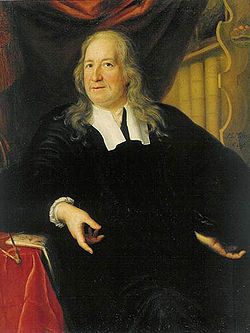Olof Rudbeck
| Olaus Rudbeck | |
|---|---|

Olaus Rudbeck, painted in 1696 by Martin Mijtens the Elder.
|
|
| Born | 12 December 1630 Västerås |
| Died | 17 September 1702 (age 71) Uppsala |
| Nationality | Swedish |
| Fields | Medicine |
| Institutions | Uppsala University |
Olaus Rudbeck (also known as Olof Rudbeck the Elder, to distinguish him from his son, and occasionally with the surname Latinized as Olaus Rudbeckius) (12 December 1630 – 17 September 1702) was a Swedish scientist and writer, professor of medicine at Uppsala University and for several periods rector magnificus of the same university. He was born in Västerås, the son of Bishop Johannes Rudbeckius, who was personal chaplain to King Gustavus Adolphus, and the father of botanist Olof Rudbeck the Younger. Rudbeck is primarily known for his contributions in two fields: human anatomy and linguistics, but he was also accomplished in many other fields including music and botany. He established the first botanical garden in Sweden at Uppsala, called Rudbeck's Garden, but which was renamed a hundred years later for his son's student, the botanist Carl Linnaeus.
Rudbeck was one of the pioneers in the study of lymphatic vessels. According to his supporters in Sweden, he was the first to discover the lymphatic system and is documented as having shown his findings at the court of Queen Christina of Sweden in the Spring of 1652. However, he did not publish anything about it until the fall of 1653, after Thomas Bartholin, a Danish scientist, had published a description of a similar discovery of his own. (For other early discoverers of the lymphatic system, see Gasparo Aselli and Jean Pecquet).
Rudbeck's research led to the Queen's support of his career. To facilitate his studies of human anatomy, he had a cupola built on top of Gustavianum, a university edifice, and in it was built an arena-like Theatrum anatomicum, where dissection could be carried out in front of students. The cupola still remains and is a landmark in Uppsala. The "Gustavianum" stands in front of the cathedral, and is still part of the university.
...
Wikipedia
